Hospital Case Study: Acute Respiratory Failure and Patient Symptoms
VerifiedAdded on 2021/04/24
|11
|3227
|163
Case Study
AI Summary
This case study focuses on a 65-year-old man, Mr. X, admitted to the hospital with acute respiratory failure. The essay meticulously details Mr. X's symptoms, including tachypnea, cyanosis, and tachycardia, along with his medical history of dyspnea and prior injuries. It delves into the pathophysiology of acute respiratory failure, linking Mr. X's condition to his history of substance abuse (alcohol, smoking, and toxic inhalants) and internal injuries. The study explores the effects of these factors on the respiratory system, including lung damage and the development of acute lung injury, hypoxemia, and potential lung cancer. The case study also discusses the diagnostic processes, including lab results, and the treatment plan, which included mechanical ventilation, medication (analgesics, humidification, and oxygen), and patient education. The importance of nursing care, including monitoring and providing support, is also highlighted, emphasizing the significance of early intervention and patient education in preventing long-term complications. The study concludes with a discussion of the potential long-term effects of acute respiratory failure and the importance of avoiding harmful substances for recovery.
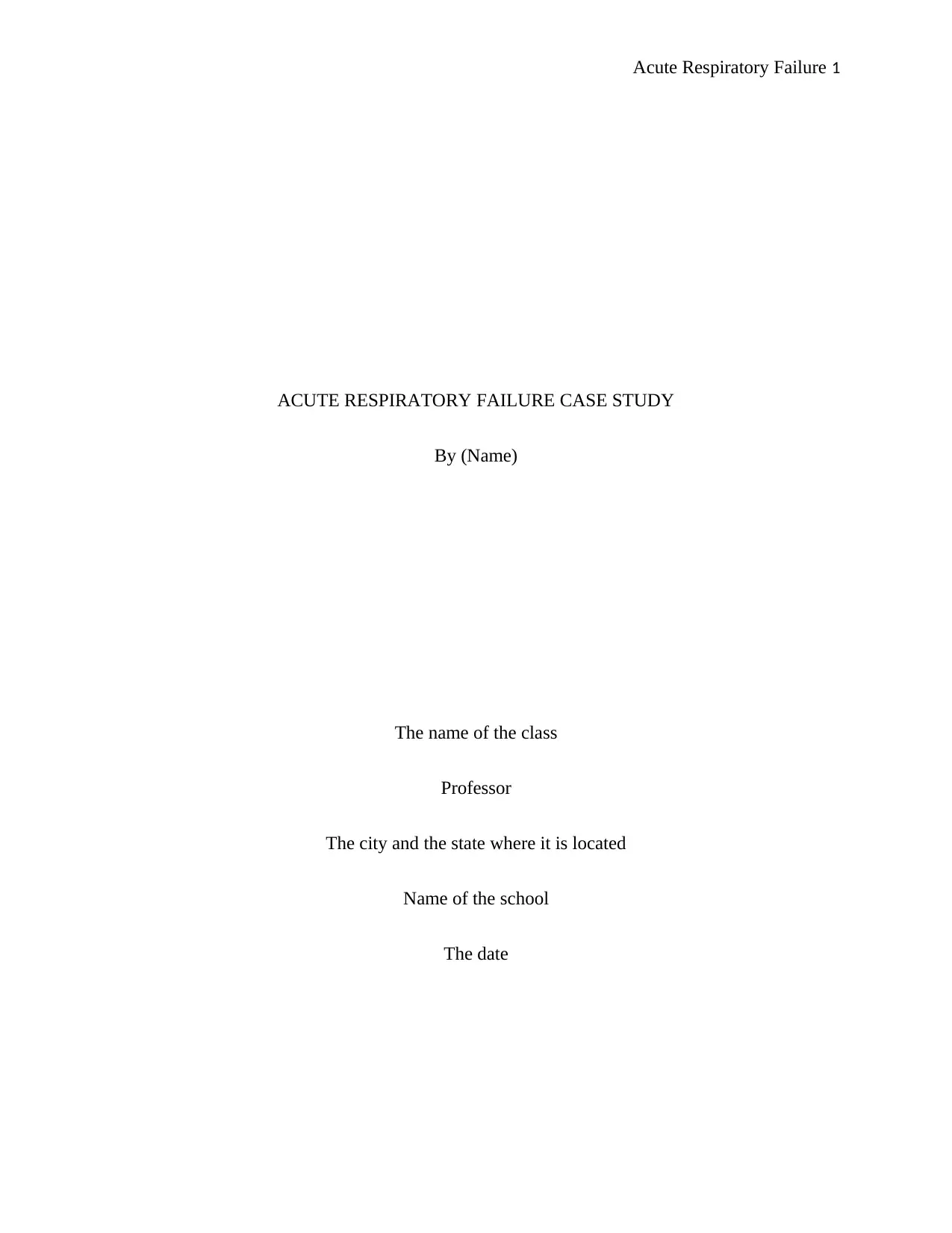
Acute Respiratory Failure 1
ACUTE RESPIRATORY FAILURE CASE STUDY
By (Name)
The name of the class
Professor
The city and the state where it is located
Name of the school
The date
ACUTE RESPIRATORY FAILURE CASE STUDY
By (Name)
The name of the class
Professor
The city and the state where it is located
Name of the school
The date
Paraphrase This Document
Need a fresh take? Get an instant paraphrase of this document with our AI Paraphraser
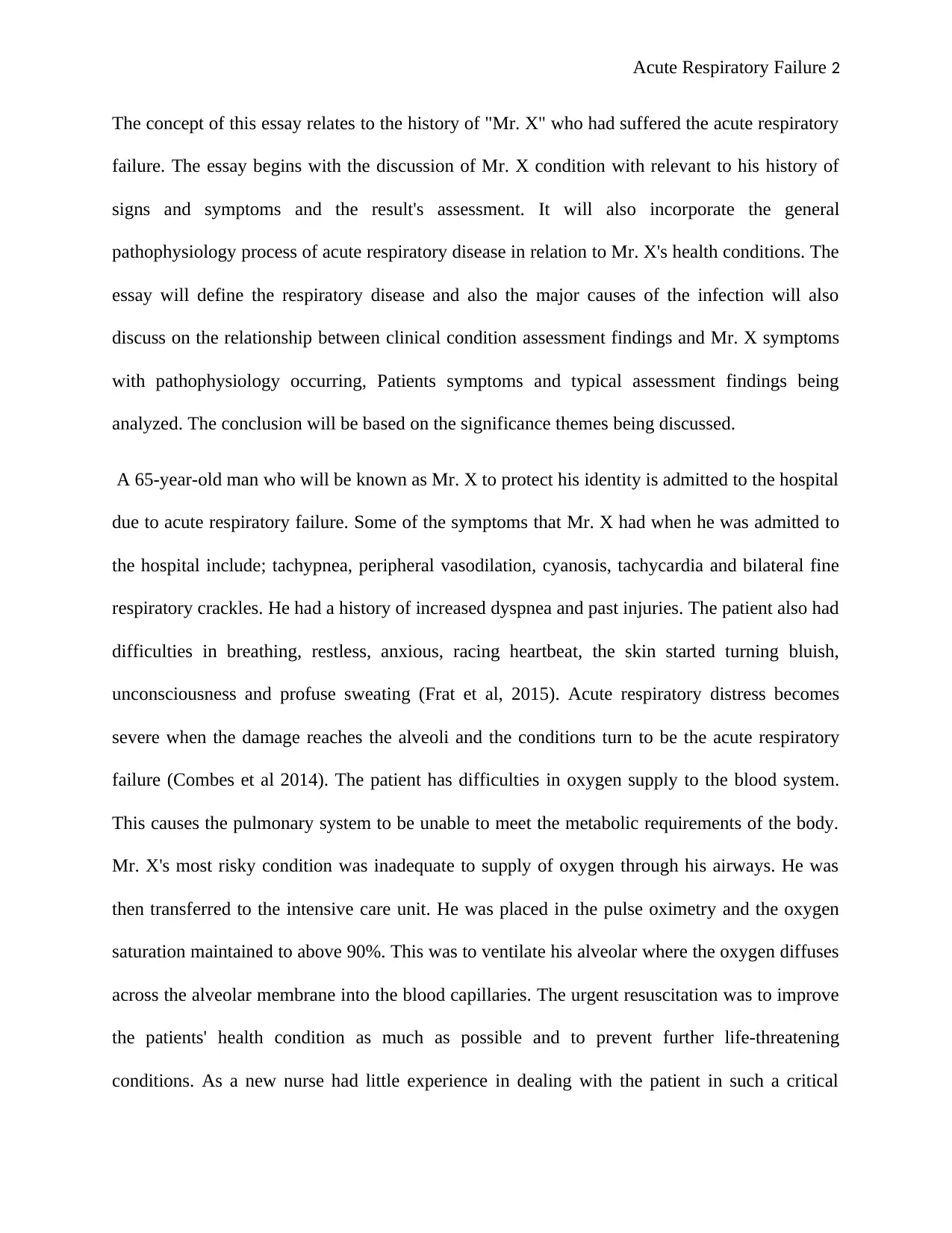
Acute Respiratory Failure 2
The concept of this essay relates to the history of "Mr. X" who had suffered the acute respiratory
failure. The essay begins with the discussion of Mr. X condition with relevant to his history of
signs and symptoms and the result's assessment. It will also incorporate the general
pathophysiology process of acute respiratory disease in relation to Mr. X's health conditions. The
essay will define the respiratory disease and also the major causes of the infection will also
discuss on the relationship between clinical condition assessment findings and Mr. X symptoms
with pathophysiology occurring, Patients symptoms and typical assessment findings being
analyzed. The conclusion will be based on the significance themes being discussed.
A 65-year-old man who will be known as Mr. X to protect his identity is admitted to the hospital
due to acute respiratory failure. Some of the symptoms that Mr. X had when he was admitted to
the hospital include; tachypnea, peripheral vasodilation, cyanosis, tachycardia and bilateral fine
respiratory crackles. He had a history of increased dyspnea and past injuries. The patient also had
difficulties in breathing, restless, anxious, racing heartbeat, the skin started turning bluish,
unconsciousness and profuse sweating (Frat et al, 2015). Acute respiratory distress becomes
severe when the damage reaches the alveoli and the conditions turn to be the acute respiratory
failure (Combes et al 2014). The patient has difficulties in oxygen supply to the blood system.
This causes the pulmonary system to be unable to meet the metabolic requirements of the body.
Mr. X's most risky condition was inadequate to supply of oxygen through his airways. He was
then transferred to the intensive care unit. He was placed in the pulse oximetry and the oxygen
saturation maintained to above 90%. This was to ventilate his alveolar where the oxygen diffuses
across the alveolar membrane into the blood capillaries. The urgent resuscitation was to improve
the patients' health condition as much as possible and to prevent further life-threatening
conditions. As a new nurse had little experience in dealing with the patient in such a critical
The concept of this essay relates to the history of "Mr. X" who had suffered the acute respiratory
failure. The essay begins with the discussion of Mr. X condition with relevant to his history of
signs and symptoms and the result's assessment. It will also incorporate the general
pathophysiology process of acute respiratory disease in relation to Mr. X's health conditions. The
essay will define the respiratory disease and also the major causes of the infection will also
discuss on the relationship between clinical condition assessment findings and Mr. X symptoms
with pathophysiology occurring, Patients symptoms and typical assessment findings being
analyzed. The conclusion will be based on the significance themes being discussed.
A 65-year-old man who will be known as Mr. X to protect his identity is admitted to the hospital
due to acute respiratory failure. Some of the symptoms that Mr. X had when he was admitted to
the hospital include; tachypnea, peripheral vasodilation, cyanosis, tachycardia and bilateral fine
respiratory crackles. He had a history of increased dyspnea and past injuries. The patient also had
difficulties in breathing, restless, anxious, racing heartbeat, the skin started turning bluish,
unconsciousness and profuse sweating (Frat et al, 2015). Acute respiratory distress becomes
severe when the damage reaches the alveoli and the conditions turn to be the acute respiratory
failure (Combes et al 2014). The patient has difficulties in oxygen supply to the blood system.
This causes the pulmonary system to be unable to meet the metabolic requirements of the body.
Mr. X's most risky condition was inadequate to supply of oxygen through his airways. He was
then transferred to the intensive care unit. He was placed in the pulse oximetry and the oxygen
saturation maintained to above 90%. This was to ventilate his alveolar where the oxygen diffuses
across the alveolar membrane into the blood capillaries. The urgent resuscitation was to improve
the patients' health condition as much as possible and to prevent further life-threatening
conditions. As a new nurse had little experience in dealing with the patient in such a critical
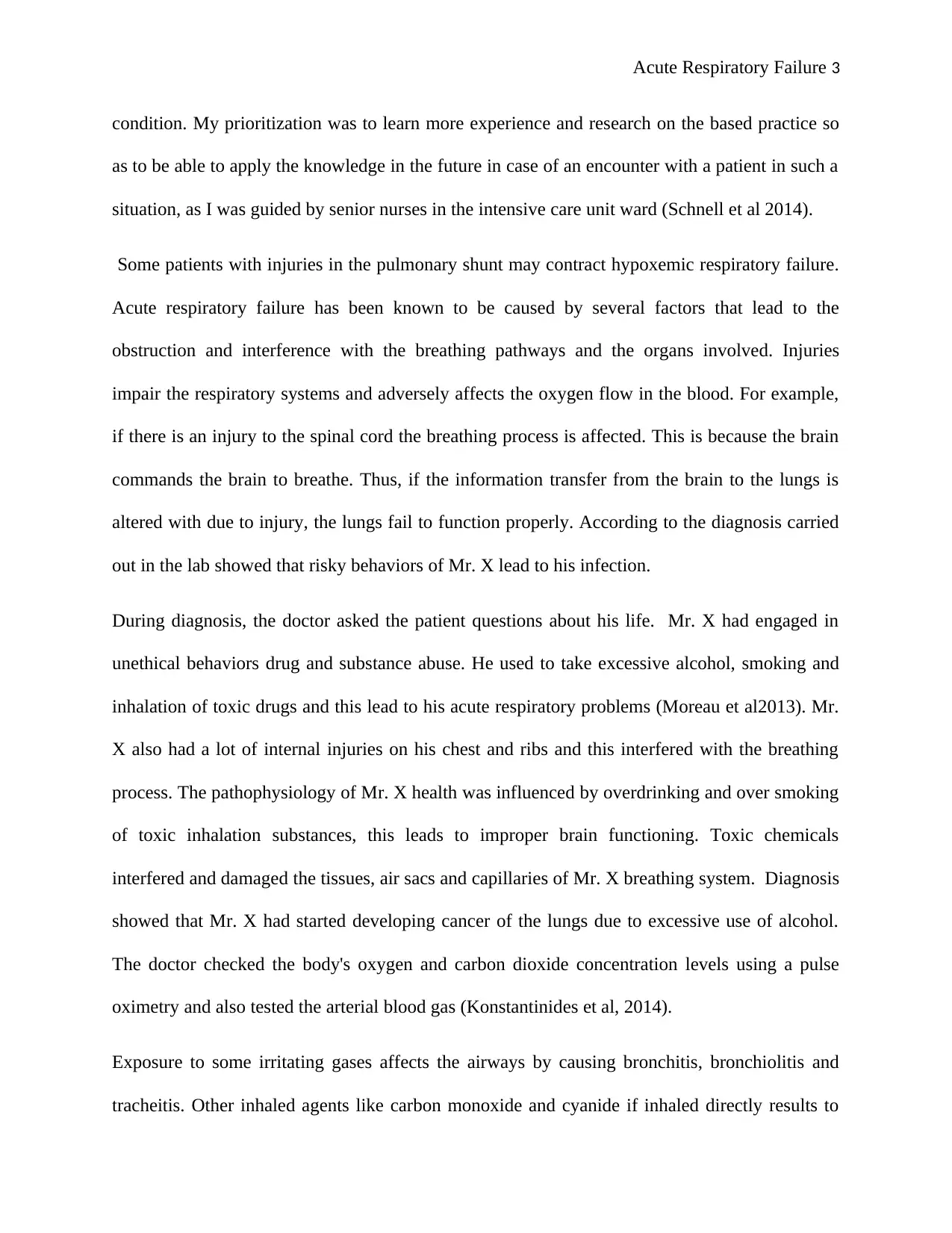
Acute Respiratory Failure 3
condition. My prioritization was to learn more experience and research on the based practice so
as to be able to apply the knowledge in the future in case of an encounter with a patient in such a
situation, as I was guided by senior nurses in the intensive care unit ward (Schnell et al 2014).
Some patients with injuries in the pulmonary shunt may contract hypoxemic respiratory failure.
Acute respiratory failure has been known to be caused by several factors that lead to the
obstruction and interference with the breathing pathways and the organs involved. Injuries
impair the respiratory systems and adversely affects the oxygen flow in the blood. For example,
if there is an injury to the spinal cord the breathing process is affected. This is because the brain
commands the brain to breathe. Thus, if the information transfer from the brain to the lungs is
altered with due to injury, the lungs fail to function properly. According to the diagnosis carried
out in the lab showed that risky behaviors of Mr. X lead to his infection.
During diagnosis, the doctor asked the patient questions about his life. Mr. X had engaged in
unethical behaviors drug and substance abuse. He used to take excessive alcohol, smoking and
inhalation of toxic drugs and this lead to his acute respiratory problems (Moreau et al2013). Mr.
X also had a lot of internal injuries on his chest and ribs and this interfered with the breathing
process. The pathophysiology of Mr. X health was influenced by overdrinking and over smoking
of toxic inhalation substances, this leads to improper brain functioning. Toxic chemicals
interfered and damaged the tissues, air sacs and capillaries of Mr. X breathing system. Diagnosis
showed that Mr. X had started developing cancer of the lungs due to excessive use of alcohol.
The doctor checked the body's oxygen and carbon dioxide concentration levels using a pulse
oximetry and also tested the arterial blood gas (Konstantinides et al, 2014).
Exposure to some irritating gases affects the airways by causing bronchitis, bronchiolitis and
tracheitis. Other inhaled agents like carbon monoxide and cyanide if inhaled directly results to
condition. My prioritization was to learn more experience and research on the based practice so
as to be able to apply the knowledge in the future in case of an encounter with a patient in such a
situation, as I was guided by senior nurses in the intensive care unit ward (Schnell et al 2014).
Some patients with injuries in the pulmonary shunt may contract hypoxemic respiratory failure.
Acute respiratory failure has been known to be caused by several factors that lead to the
obstruction and interference with the breathing pathways and the organs involved. Injuries
impair the respiratory systems and adversely affects the oxygen flow in the blood. For example,
if there is an injury to the spinal cord the breathing process is affected. This is because the brain
commands the brain to breathe. Thus, if the information transfer from the brain to the lungs is
altered with due to injury, the lungs fail to function properly. According to the diagnosis carried
out in the lab showed that risky behaviors of Mr. X lead to his infection.
During diagnosis, the doctor asked the patient questions about his life. Mr. X had engaged in
unethical behaviors drug and substance abuse. He used to take excessive alcohol, smoking and
inhalation of toxic drugs and this lead to his acute respiratory problems (Moreau et al2013). Mr.
X also had a lot of internal injuries on his chest and ribs and this interfered with the breathing
process. The pathophysiology of Mr. X health was influenced by overdrinking and over smoking
of toxic inhalation substances, this leads to improper brain functioning. Toxic chemicals
interfered and damaged the tissues, air sacs and capillaries of Mr. X breathing system. Diagnosis
showed that Mr. X had started developing cancer of the lungs due to excessive use of alcohol.
The doctor checked the body's oxygen and carbon dioxide concentration levels using a pulse
oximetry and also tested the arterial blood gas (Konstantinides et al, 2014).
Exposure to some irritating gases affects the airways by causing bronchitis, bronchiolitis and
tracheitis. Other inhaled agents like carbon monoxide and cyanide if inhaled directly results to
⊘ This is a preview!⊘
Do you want full access?
Subscribe today to unlock all pages.

Trusted by 1+ million students worldwide
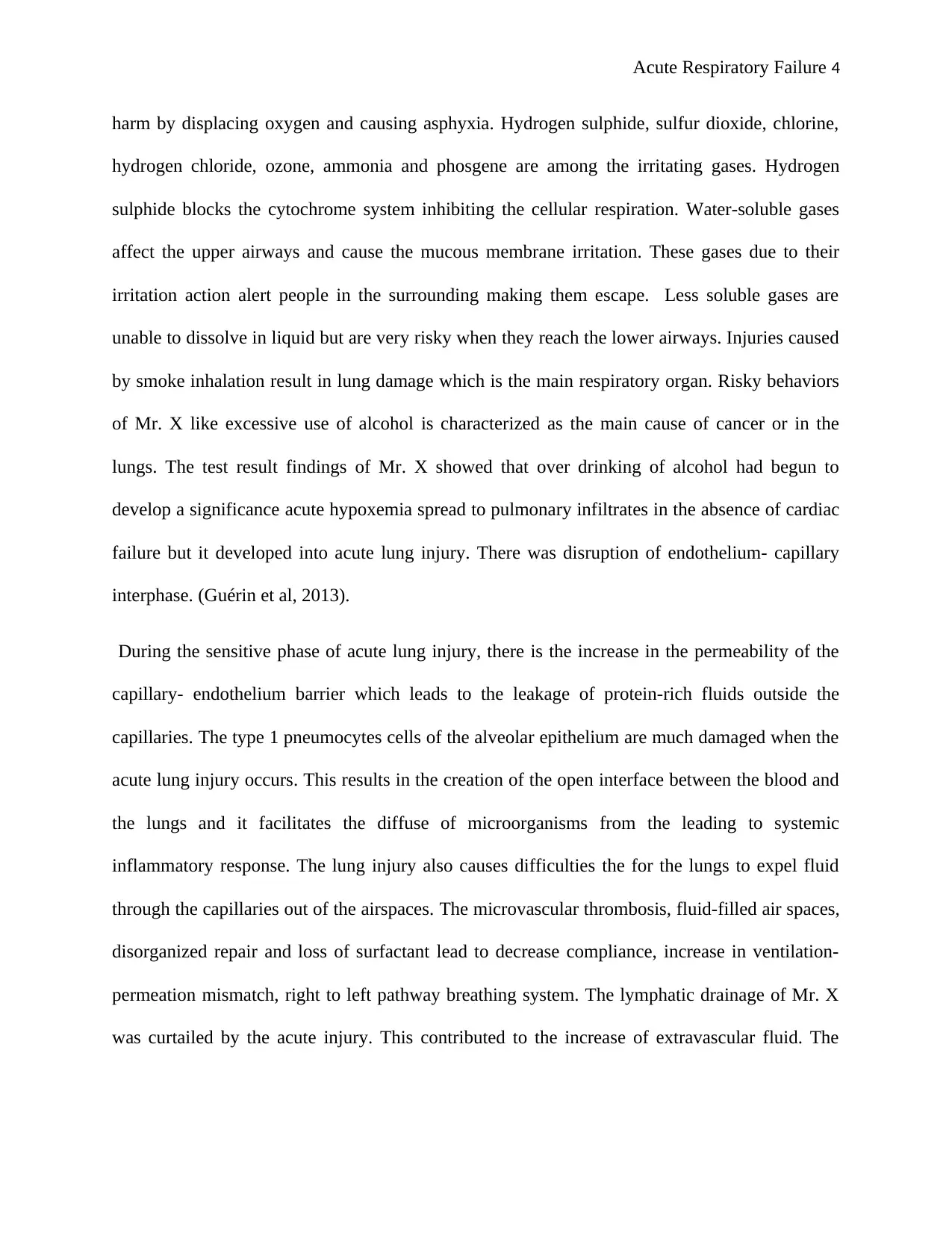
Acute Respiratory Failure 4
harm by displacing oxygen and causing asphyxia. Hydrogen sulphide, sulfur dioxide, chlorine,
hydrogen chloride, ozone, ammonia and phosgene are among the irritating gases. Hydrogen
sulphide blocks the cytochrome system inhibiting the cellular respiration. Water-soluble gases
affect the upper airways and cause the mucous membrane irritation. These gases due to their
irritation action alert people in the surrounding making them escape. Less soluble gases are
unable to dissolve in liquid but are very risky when they reach the lower airways. Injuries caused
by smoke inhalation result in lung damage which is the main respiratory organ. Risky behaviors
of Mr. X like excessive use of alcohol is characterized as the main cause of cancer or in the
lungs. The test result findings of Mr. X showed that over drinking of alcohol had begun to
develop a significance acute hypoxemia spread to pulmonary infiltrates in the absence of cardiac
failure but it developed into acute lung injury. There was disruption of endothelium- capillary
interphase. (Guérin et al, 2013).
During the sensitive phase of acute lung injury, there is the increase in the permeability of the
capillary- endothelium barrier which leads to the leakage of protein-rich fluids outside the
capillaries. The type 1 pneumocytes cells of the alveolar epithelium are much damaged when the
acute lung injury occurs. This results in the creation of the open interface between the blood and
the lungs and it facilitates the diffuse of microorganisms from the leading to systemic
inflammatory response. The lung injury also causes difficulties the for the lungs to expel fluid
through the capillaries out of the airspaces. The microvascular thrombosis, fluid-filled air spaces,
disorganized repair and loss of surfactant lead to decrease compliance, increase in ventilation-
permeation mismatch, right to left pathway breathing system. The lymphatic drainage of Mr. X
was curtailed by the acute injury. This contributed to the increase of extravascular fluid. The
harm by displacing oxygen and causing asphyxia. Hydrogen sulphide, sulfur dioxide, chlorine,
hydrogen chloride, ozone, ammonia and phosgene are among the irritating gases. Hydrogen
sulphide blocks the cytochrome system inhibiting the cellular respiration. Water-soluble gases
affect the upper airways and cause the mucous membrane irritation. These gases due to their
irritation action alert people in the surrounding making them escape. Less soluble gases are
unable to dissolve in liquid but are very risky when they reach the lower airways. Injuries caused
by smoke inhalation result in lung damage which is the main respiratory organ. Risky behaviors
of Mr. X like excessive use of alcohol is characterized as the main cause of cancer or in the
lungs. The test result findings of Mr. X showed that over drinking of alcohol had begun to
develop a significance acute hypoxemia spread to pulmonary infiltrates in the absence of cardiac
failure but it developed into acute lung injury. There was disruption of endothelium- capillary
interphase. (Guérin et al, 2013).
During the sensitive phase of acute lung injury, there is the increase in the permeability of the
capillary- endothelium barrier which leads to the leakage of protein-rich fluids outside the
capillaries. The type 1 pneumocytes cells of the alveolar epithelium are much damaged when the
acute lung injury occurs. This results in the creation of the open interface between the blood and
the lungs and it facilitates the diffuse of microorganisms from the leading to systemic
inflammatory response. The lung injury also causes difficulties the for the lungs to expel fluid
through the capillaries out of the airspaces. The microvascular thrombosis, fluid-filled air spaces,
disorganized repair and loss of surfactant lead to decrease compliance, increase in ventilation-
permeation mismatch, right to left pathway breathing system. The lymphatic drainage of Mr. X
was curtailed by the acute injury. This contributed to the increase of extravascular fluid. The
Paraphrase This Document
Need a fresh take? Get an instant paraphrase of this document with our AI Paraphraser
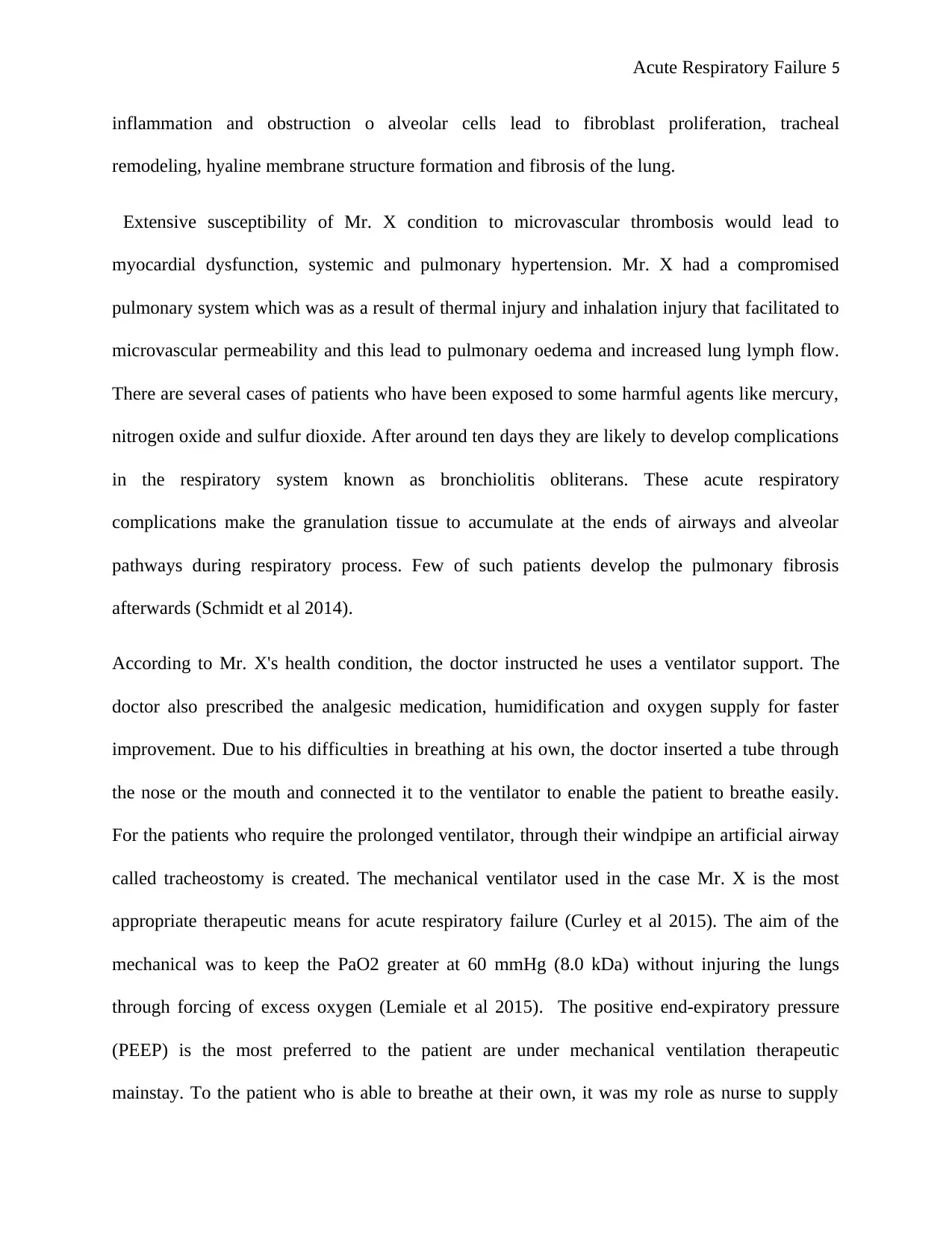
Acute Respiratory Failure 5
inflammation and obstruction o alveolar cells lead to fibroblast proliferation, tracheal
remodeling, hyaline membrane structure formation and fibrosis of the lung.
Extensive susceptibility of Mr. X condition to microvascular thrombosis would lead to
myocardial dysfunction, systemic and pulmonary hypertension. Mr. X had a compromised
pulmonary system which was as a result of thermal injury and inhalation injury that facilitated to
microvascular permeability and this lead to pulmonary oedema and increased lung lymph flow.
There are several cases of patients who have been exposed to some harmful agents like mercury,
nitrogen oxide and sulfur dioxide. After around ten days they are likely to develop complications
in the respiratory system known as bronchiolitis obliterans. These acute respiratory
complications make the granulation tissue to accumulate at the ends of airways and alveolar
pathways during respiratory process. Few of such patients develop the pulmonary fibrosis
afterwards (Schmidt et al 2014).
According to Mr. X's health condition, the doctor instructed he uses a ventilator support. The
doctor also prescribed the analgesic medication, humidification and oxygen supply for faster
improvement. Due to his difficulties in breathing at his own, the doctor inserted a tube through
the nose or the mouth and connected it to the ventilator to enable the patient to breathe easily.
For the patients who require the prolonged ventilator, through their windpipe an artificial airway
called tracheostomy is created. The mechanical ventilator used in the case Mr. X is the most
appropriate therapeutic means for acute respiratory failure (Curley et al 2015). The aim of the
mechanical was to keep the PaO2 greater at 60 mmHg (8.0 kDa) without injuring the lungs
through forcing of excess oxygen (Lemiale et al 2015). The positive end-expiratory pressure
(PEEP) is the most preferred to the patient are under mechanical ventilation therapeutic
mainstay. To the patient who is able to breathe at their own, it was my role as nurse to supply
inflammation and obstruction o alveolar cells lead to fibroblast proliferation, tracheal
remodeling, hyaline membrane structure formation and fibrosis of the lung.
Extensive susceptibility of Mr. X condition to microvascular thrombosis would lead to
myocardial dysfunction, systemic and pulmonary hypertension. Mr. X had a compromised
pulmonary system which was as a result of thermal injury and inhalation injury that facilitated to
microvascular permeability and this lead to pulmonary oedema and increased lung lymph flow.
There are several cases of patients who have been exposed to some harmful agents like mercury,
nitrogen oxide and sulfur dioxide. After around ten days they are likely to develop complications
in the respiratory system known as bronchiolitis obliterans. These acute respiratory
complications make the granulation tissue to accumulate at the ends of airways and alveolar
pathways during respiratory process. Few of such patients develop the pulmonary fibrosis
afterwards (Schmidt et al 2014).
According to Mr. X's health condition, the doctor instructed he uses a ventilator support. The
doctor also prescribed the analgesic medication, humidification and oxygen supply for faster
improvement. Due to his difficulties in breathing at his own, the doctor inserted a tube through
the nose or the mouth and connected it to the ventilator to enable the patient to breathe easily.
For the patients who require the prolonged ventilator, through their windpipe an artificial airway
called tracheostomy is created. The mechanical ventilator used in the case Mr. X is the most
appropriate therapeutic means for acute respiratory failure (Curley et al 2015). The aim of the
mechanical was to keep the PaO2 greater at 60 mmHg (8.0 kDa) without injuring the lungs
through forcing of excess oxygen (Lemiale et al 2015). The positive end-expiratory pressure
(PEEP) is the most preferred to the patient are under mechanical ventilation therapeutic
mainstay. To the patient who is able to breathe at their own, it was my role as nurse to supply
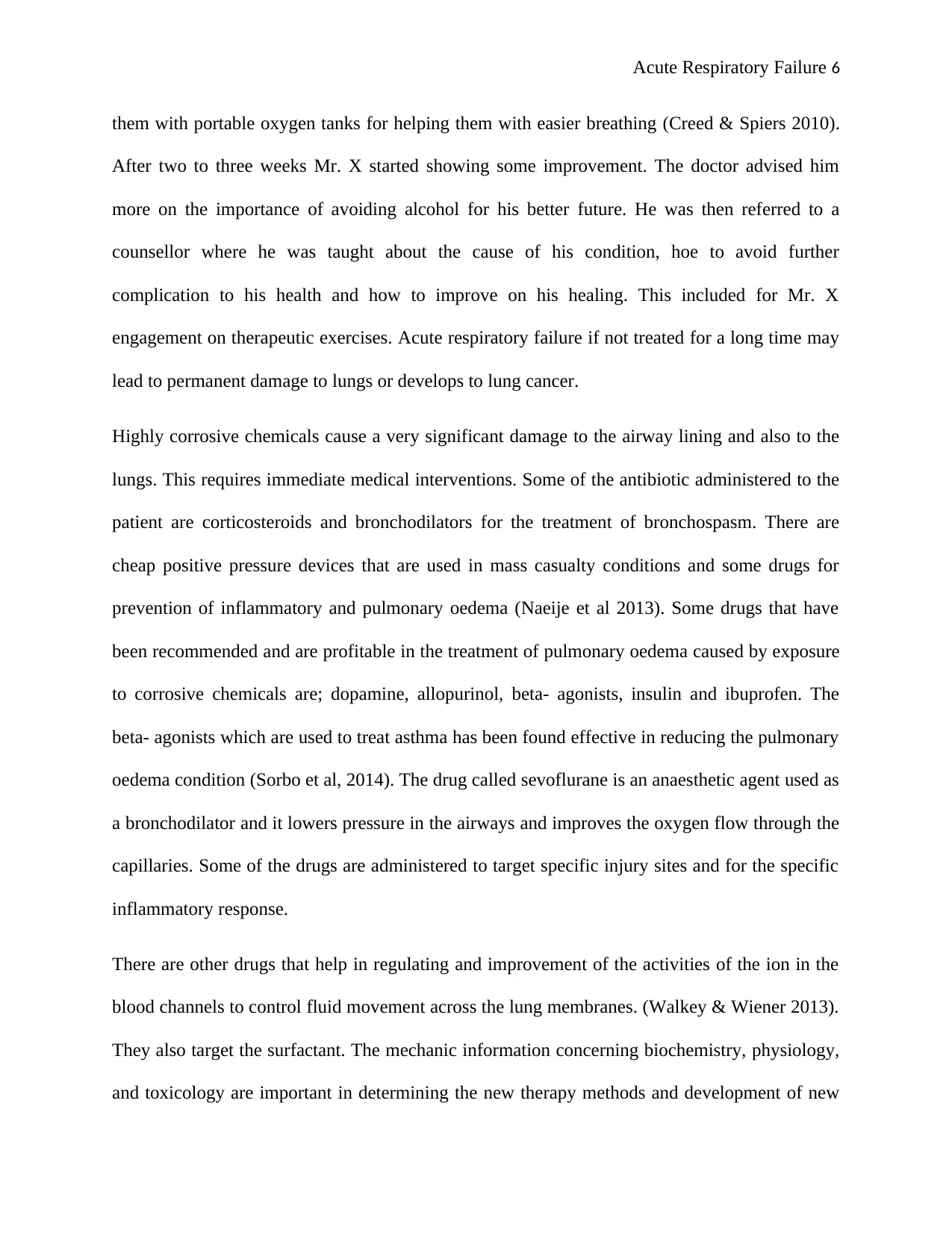
Acute Respiratory Failure 6
them with portable oxygen tanks for helping them with easier breathing (Creed & Spiers 2010).
After two to three weeks Mr. X started showing some improvement. The doctor advised him
more on the importance of avoiding alcohol for his better future. He was then referred to a
counsellor where he was taught about the cause of his condition, hoe to avoid further
complication to his health and how to improve on his healing. This included for Mr. X
engagement on therapeutic exercises. Acute respiratory failure if not treated for a long time may
lead to permanent damage to lungs or develops to lung cancer.
Highly corrosive chemicals cause a very significant damage to the airway lining and also to the
lungs. This requires immediate medical interventions. Some of the antibiotic administered to the
patient are corticosteroids and bronchodilators for the treatment of bronchospasm. There are
cheap positive pressure devices that are used in mass casualty conditions and some drugs for
prevention of inflammatory and pulmonary oedema (Naeije et al 2013). Some drugs that have
been recommended and are profitable in the treatment of pulmonary oedema caused by exposure
to corrosive chemicals are; dopamine, allopurinol, beta- agonists, insulin and ibuprofen. The
beta- agonists which are used to treat asthma has been found effective in reducing the pulmonary
oedema condition (Sorbo et al, 2014). The drug called sevoflurane is an anaesthetic agent used as
a bronchodilator and it lowers pressure in the airways and improves the oxygen flow through the
capillaries. Some of the drugs are administered to target specific injury sites and for the specific
inflammatory response.
There are other drugs that help in regulating and improvement of the activities of the ion in the
blood channels to control fluid movement across the lung membranes. (Walkey & Wiener 2013).
They also target the surfactant. The mechanic information concerning biochemistry, physiology,
and toxicology are important in determining the new therapy methods and development of new
them with portable oxygen tanks for helping them with easier breathing (Creed & Spiers 2010).
After two to three weeks Mr. X started showing some improvement. The doctor advised him
more on the importance of avoiding alcohol for his better future. He was then referred to a
counsellor where he was taught about the cause of his condition, hoe to avoid further
complication to his health and how to improve on his healing. This included for Mr. X
engagement on therapeutic exercises. Acute respiratory failure if not treated for a long time may
lead to permanent damage to lungs or develops to lung cancer.
Highly corrosive chemicals cause a very significant damage to the airway lining and also to the
lungs. This requires immediate medical interventions. Some of the antibiotic administered to the
patient are corticosteroids and bronchodilators for the treatment of bronchospasm. There are
cheap positive pressure devices that are used in mass casualty conditions and some drugs for
prevention of inflammatory and pulmonary oedema (Naeije et al 2013). Some drugs that have
been recommended and are profitable in the treatment of pulmonary oedema caused by exposure
to corrosive chemicals are; dopamine, allopurinol, beta- agonists, insulin and ibuprofen. The
beta- agonists which are used to treat asthma has been found effective in reducing the pulmonary
oedema condition (Sorbo et al, 2014). The drug called sevoflurane is an anaesthetic agent used as
a bronchodilator and it lowers pressure in the airways and improves the oxygen flow through the
capillaries. Some of the drugs are administered to target specific injury sites and for the specific
inflammatory response.
There are other drugs that help in regulating and improvement of the activities of the ion in the
blood channels to control fluid movement across the lung membranes. (Walkey & Wiener 2013).
They also target the surfactant. The mechanic information concerning biochemistry, physiology,
and toxicology are important in determining the new therapy methods and development of new
⊘ This is a preview!⊘
Do you want full access?
Subscribe today to unlock all pages.

Trusted by 1+ million students worldwide
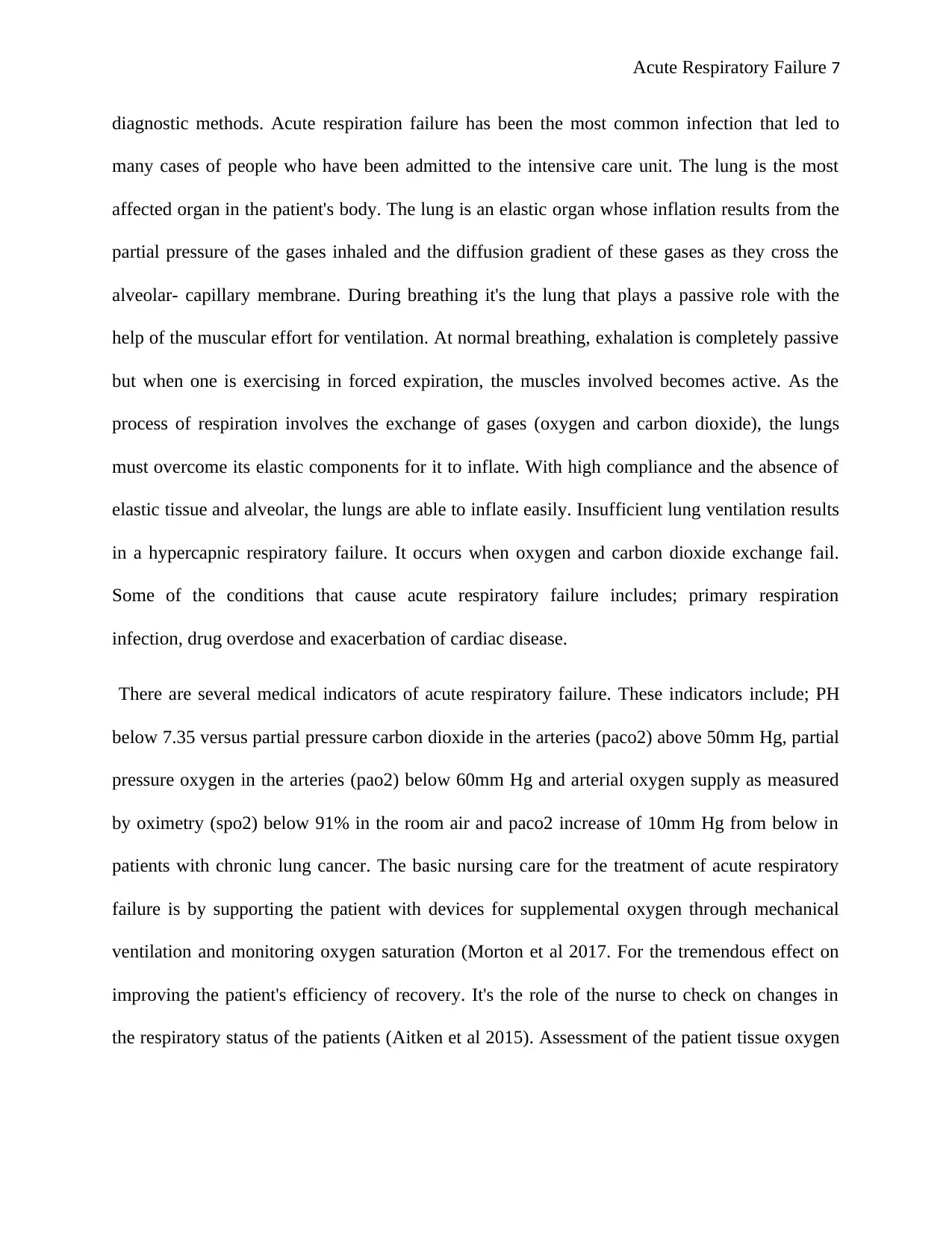
Acute Respiratory Failure 7
diagnostic methods. Acute respiration failure has been the most common infection that led to
many cases of people who have been admitted to the intensive care unit. The lung is the most
affected organ in the patient's body. The lung is an elastic organ whose inflation results from the
partial pressure of the gases inhaled and the diffusion gradient of these gases as they cross the
alveolar- capillary membrane. During breathing it's the lung that plays a passive role with the
help of the muscular effort for ventilation. At normal breathing, exhalation is completely passive
but when one is exercising in forced expiration, the muscles involved becomes active. As the
process of respiration involves the exchange of gases (oxygen and carbon dioxide), the lungs
must overcome its elastic components for it to inflate. With high compliance and the absence of
elastic tissue and alveolar, the lungs are able to inflate easily. Insufficient lung ventilation results
in a hypercapnic respiratory failure. It occurs when oxygen and carbon dioxide exchange fail.
Some of the conditions that cause acute respiratory failure includes; primary respiration
infection, drug overdose and exacerbation of cardiac disease.
There are several medical indicators of acute respiratory failure. These indicators include; PH
below 7.35 versus partial pressure carbon dioxide in the arteries (paco2) above 50mm Hg, partial
pressure oxygen in the arteries (pao2) below 60mm Hg and arterial oxygen supply as measured
by oximetry (spo2) below 91% in the room air and paco2 increase of 10mm Hg from below in
patients with chronic lung cancer. The basic nursing care for the treatment of acute respiratory
failure is by supporting the patient with devices for supplemental oxygen through mechanical
ventilation and monitoring oxygen saturation (Morton et al 2017. For the tremendous effect on
improving the patient's efficiency of recovery. It's the role of the nurse to check on changes in
the respiratory status of the patients (Aitken et al 2015). Assessment of the patient tissue oxygen
diagnostic methods. Acute respiration failure has been the most common infection that led to
many cases of people who have been admitted to the intensive care unit. The lung is the most
affected organ in the patient's body. The lung is an elastic organ whose inflation results from the
partial pressure of the gases inhaled and the diffusion gradient of these gases as they cross the
alveolar- capillary membrane. During breathing it's the lung that plays a passive role with the
help of the muscular effort for ventilation. At normal breathing, exhalation is completely passive
but when one is exercising in forced expiration, the muscles involved becomes active. As the
process of respiration involves the exchange of gases (oxygen and carbon dioxide), the lungs
must overcome its elastic components for it to inflate. With high compliance and the absence of
elastic tissue and alveolar, the lungs are able to inflate easily. Insufficient lung ventilation results
in a hypercapnic respiratory failure. It occurs when oxygen and carbon dioxide exchange fail.
Some of the conditions that cause acute respiratory failure includes; primary respiration
infection, drug overdose and exacerbation of cardiac disease.
There are several medical indicators of acute respiratory failure. These indicators include; PH
below 7.35 versus partial pressure carbon dioxide in the arteries (paco2) above 50mm Hg, partial
pressure oxygen in the arteries (pao2) below 60mm Hg and arterial oxygen supply as measured
by oximetry (spo2) below 91% in the room air and paco2 increase of 10mm Hg from below in
patients with chronic lung cancer. The basic nursing care for the treatment of acute respiratory
failure is by supporting the patient with devices for supplemental oxygen through mechanical
ventilation and monitoring oxygen saturation (Morton et al 2017. For the tremendous effect on
improving the patient's efficiency of recovery. It's the role of the nurse to check on changes in
the respiratory status of the patients (Aitken et al 2015). Assessment of the patient tissue oxygen
Paraphrase This Document
Need a fresh take? Get an instant paraphrase of this document with our AI Paraphraser
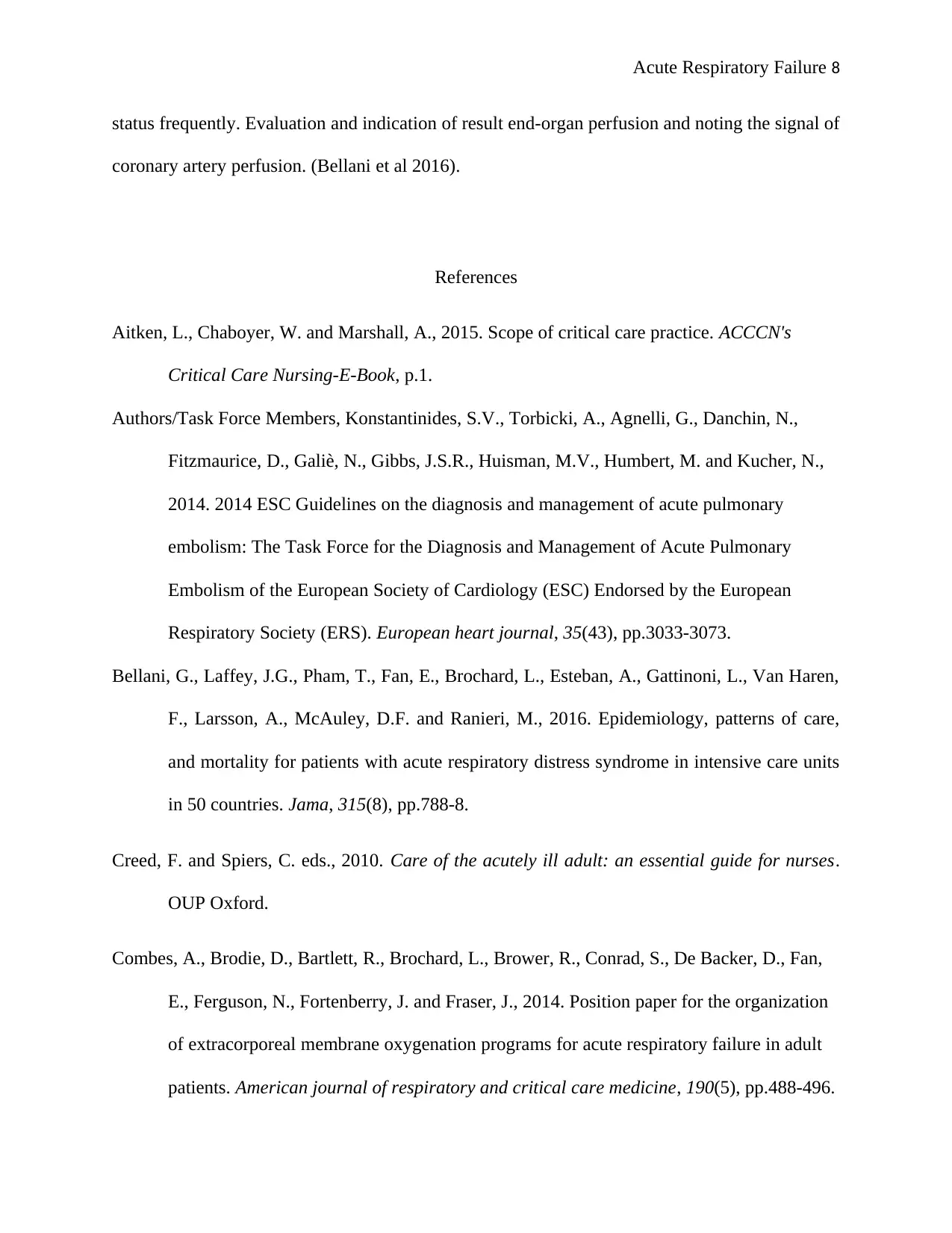
Acute Respiratory Failure 8
status frequently. Evaluation and indication of result end-organ perfusion and noting the signal of
coronary artery perfusion. (Bellani et al 2016).
References
Aitken, L., Chaboyer, W. and Marshall, A., 2015. Scope of critical care practice. ACCCN's
Critical Care Nursing-E-Book, p.1.
Authors/Task Force Members, Konstantinides, S.V., Torbicki, A., Agnelli, G., Danchin, N.,
Fitzmaurice, D., Galiè, N., Gibbs, J.S.R., Huisman, M.V., Humbert, M. and Kucher, N.,
2014. 2014 ESC Guidelines on the diagnosis and management of acute pulmonary
embolism: The Task Force for the Diagnosis and Management of Acute Pulmonary
Embolism of the European Society of Cardiology (ESC) Endorsed by the European
Respiratory Society (ERS). European heart journal, 35(43), pp.3033-3073.
Bellani, G., Laffey, J.G., Pham, T., Fan, E., Brochard, L., Esteban, A., Gattinoni, L., Van Haren,
F., Larsson, A., McAuley, D.F. and Ranieri, M., 2016. Epidemiology, patterns of care,
and mortality for patients with acute respiratory distress syndrome in intensive care units
in 50 countries. Jama, 315(8), pp.788-8.
Creed, F. and Spiers, C. eds., 2010. Care of the acutely ill adult: an essential guide for nurses.
OUP Oxford.
Combes, A., Brodie, D., Bartlett, R., Brochard, L., Brower, R., Conrad, S., De Backer, D., Fan,
E., Ferguson, N., Fortenberry, J. and Fraser, J., 2014. Position paper for the organization
of extracorporeal membrane oxygenation programs for acute respiratory failure in adult
patients. American journal of respiratory and critical care medicine, 190(5), pp.488-496.
status frequently. Evaluation and indication of result end-organ perfusion and noting the signal of
coronary artery perfusion. (Bellani et al 2016).
References
Aitken, L., Chaboyer, W. and Marshall, A., 2015. Scope of critical care practice. ACCCN's
Critical Care Nursing-E-Book, p.1.
Authors/Task Force Members, Konstantinides, S.V., Torbicki, A., Agnelli, G., Danchin, N.,
Fitzmaurice, D., Galiè, N., Gibbs, J.S.R., Huisman, M.V., Humbert, M. and Kucher, N.,
2014. 2014 ESC Guidelines on the diagnosis and management of acute pulmonary
embolism: The Task Force for the Diagnosis and Management of Acute Pulmonary
Embolism of the European Society of Cardiology (ESC) Endorsed by the European
Respiratory Society (ERS). European heart journal, 35(43), pp.3033-3073.
Bellani, G., Laffey, J.G., Pham, T., Fan, E., Brochard, L., Esteban, A., Gattinoni, L., Van Haren,
F., Larsson, A., McAuley, D.F. and Ranieri, M., 2016. Epidemiology, patterns of care,
and mortality for patients with acute respiratory distress syndrome in intensive care units
in 50 countries. Jama, 315(8), pp.788-8.
Creed, F. and Spiers, C. eds., 2010. Care of the acutely ill adult: an essential guide for nurses.
OUP Oxford.
Combes, A., Brodie, D., Bartlett, R., Brochard, L., Brower, R., Conrad, S., De Backer, D., Fan,
E., Ferguson, N., Fortenberry, J. and Fraser, J., 2014. Position paper for the organization
of extracorporeal membrane oxygenation programs for acute respiratory failure in adult
patients. American journal of respiratory and critical care medicine, 190(5), pp.488-496.
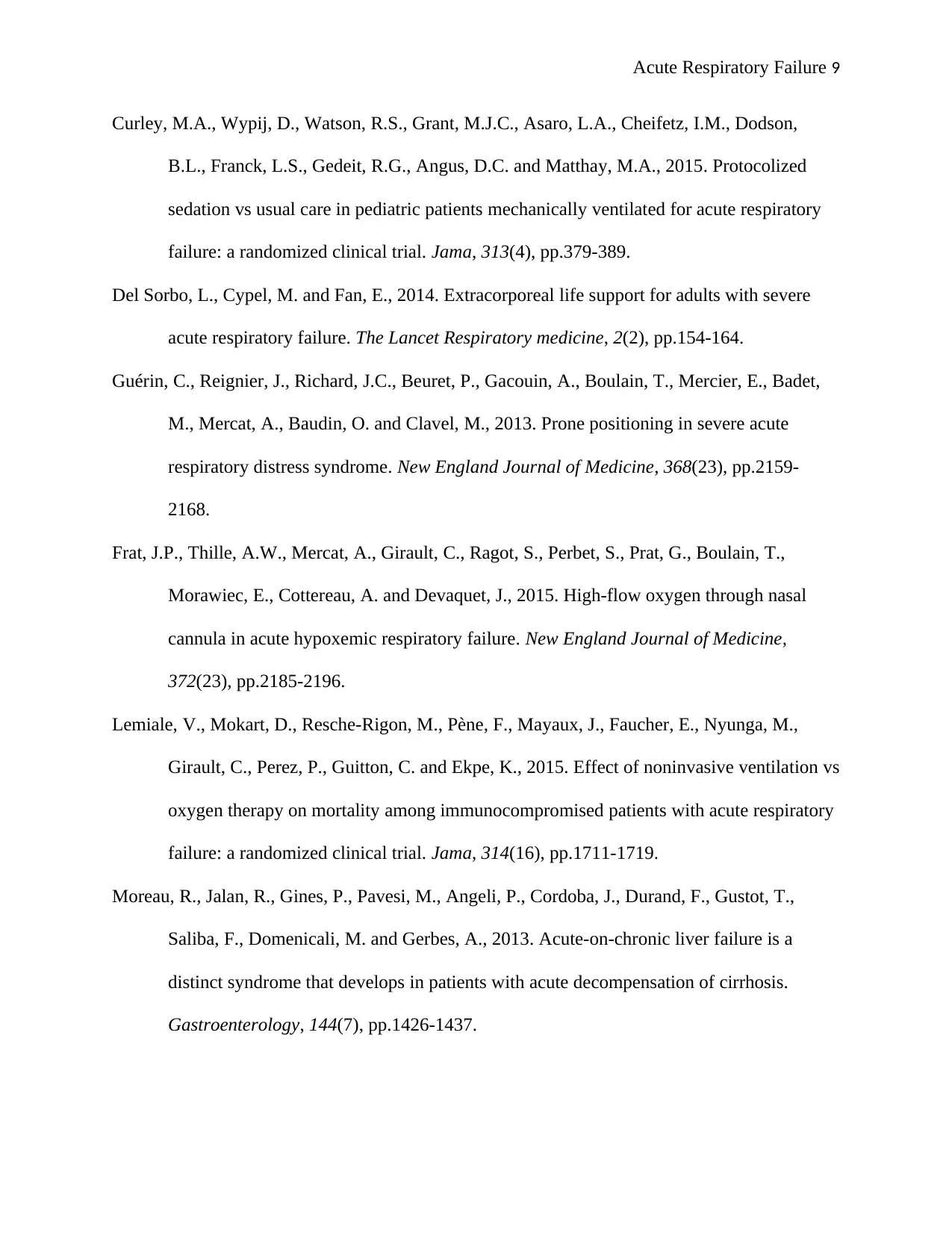
Acute Respiratory Failure 9
Curley, M.A., Wypij, D., Watson, R.S., Grant, M.J.C., Asaro, L.A., Cheifetz, I.M., Dodson,
B.L., Franck, L.S., Gedeit, R.G., Angus, D.C. and Matthay, M.A., 2015. Protocolized
sedation vs usual care in pediatric patients mechanically ventilated for acute respiratory
failure: a randomized clinical trial. Jama, 313(4), pp.379-389.
Del Sorbo, L., Cypel, M. and Fan, E., 2014. Extracorporeal life support for adults with severe
acute respiratory failure. The Lancet Respiratory medicine, 2(2), pp.154-164.
Guérin, C., Reignier, J., Richard, J.C., Beuret, P., Gacouin, A., Boulain, T., Mercier, E., Badet,
M., Mercat, A., Baudin, O. and Clavel, M., 2013. Prone positioning in severe acute
respiratory distress syndrome. New England Journal of Medicine, 368(23), pp.2159-
2168.
Frat, J.P., Thille, A.W., Mercat, A., Girault, C., Ragot, S., Perbet, S., Prat, G., Boulain, T.,
Morawiec, E., Cottereau, A. and Devaquet, J., 2015. High-flow oxygen through nasal
cannula in acute hypoxemic respiratory failure. New England Journal of Medicine,
372(23), pp.2185-2196.
Lemiale, V., Mokart, D., Resche-Rigon, M., Pène, F., Mayaux, J., Faucher, E., Nyunga, M.,
Girault, C., Perez, P., Guitton, C. and Ekpe, K., 2015. Effect of noninvasive ventilation vs
oxygen therapy on mortality among immunocompromised patients with acute respiratory
failure: a randomized clinical trial. Jama, 314(16), pp.1711-1719.
Moreau, R., Jalan, R., Gines, P., Pavesi, M., Angeli, P., Cordoba, J., Durand, F., Gustot, T.,
Saliba, F., Domenicali, M. and Gerbes, A., 2013. Acute-on-chronic liver failure is a
distinct syndrome that develops in patients with acute decompensation of cirrhosis.
Gastroenterology, 144(7), pp.1426-1437.
Curley, M.A., Wypij, D., Watson, R.S., Grant, M.J.C., Asaro, L.A., Cheifetz, I.M., Dodson,
B.L., Franck, L.S., Gedeit, R.G., Angus, D.C. and Matthay, M.A., 2015. Protocolized
sedation vs usual care in pediatric patients mechanically ventilated for acute respiratory
failure: a randomized clinical trial. Jama, 313(4), pp.379-389.
Del Sorbo, L., Cypel, M. and Fan, E., 2014. Extracorporeal life support for adults with severe
acute respiratory failure. The Lancet Respiratory medicine, 2(2), pp.154-164.
Guérin, C., Reignier, J., Richard, J.C., Beuret, P., Gacouin, A., Boulain, T., Mercier, E., Badet,
M., Mercat, A., Baudin, O. and Clavel, M., 2013. Prone positioning in severe acute
respiratory distress syndrome. New England Journal of Medicine, 368(23), pp.2159-
2168.
Frat, J.P., Thille, A.W., Mercat, A., Girault, C., Ragot, S., Perbet, S., Prat, G., Boulain, T.,
Morawiec, E., Cottereau, A. and Devaquet, J., 2015. High-flow oxygen through nasal
cannula in acute hypoxemic respiratory failure. New England Journal of Medicine,
372(23), pp.2185-2196.
Lemiale, V., Mokart, D., Resche-Rigon, M., Pène, F., Mayaux, J., Faucher, E., Nyunga, M.,
Girault, C., Perez, P., Guitton, C. and Ekpe, K., 2015. Effect of noninvasive ventilation vs
oxygen therapy on mortality among immunocompromised patients with acute respiratory
failure: a randomized clinical trial. Jama, 314(16), pp.1711-1719.
Moreau, R., Jalan, R., Gines, P., Pavesi, M., Angeli, P., Cordoba, J., Durand, F., Gustot, T.,
Saliba, F., Domenicali, M. and Gerbes, A., 2013. Acute-on-chronic liver failure is a
distinct syndrome that develops in patients with acute decompensation of cirrhosis.
Gastroenterology, 144(7), pp.1426-1437.
⊘ This is a preview!⊘
Do you want full access?
Subscribe today to unlock all pages.

Trusted by 1+ million students worldwide
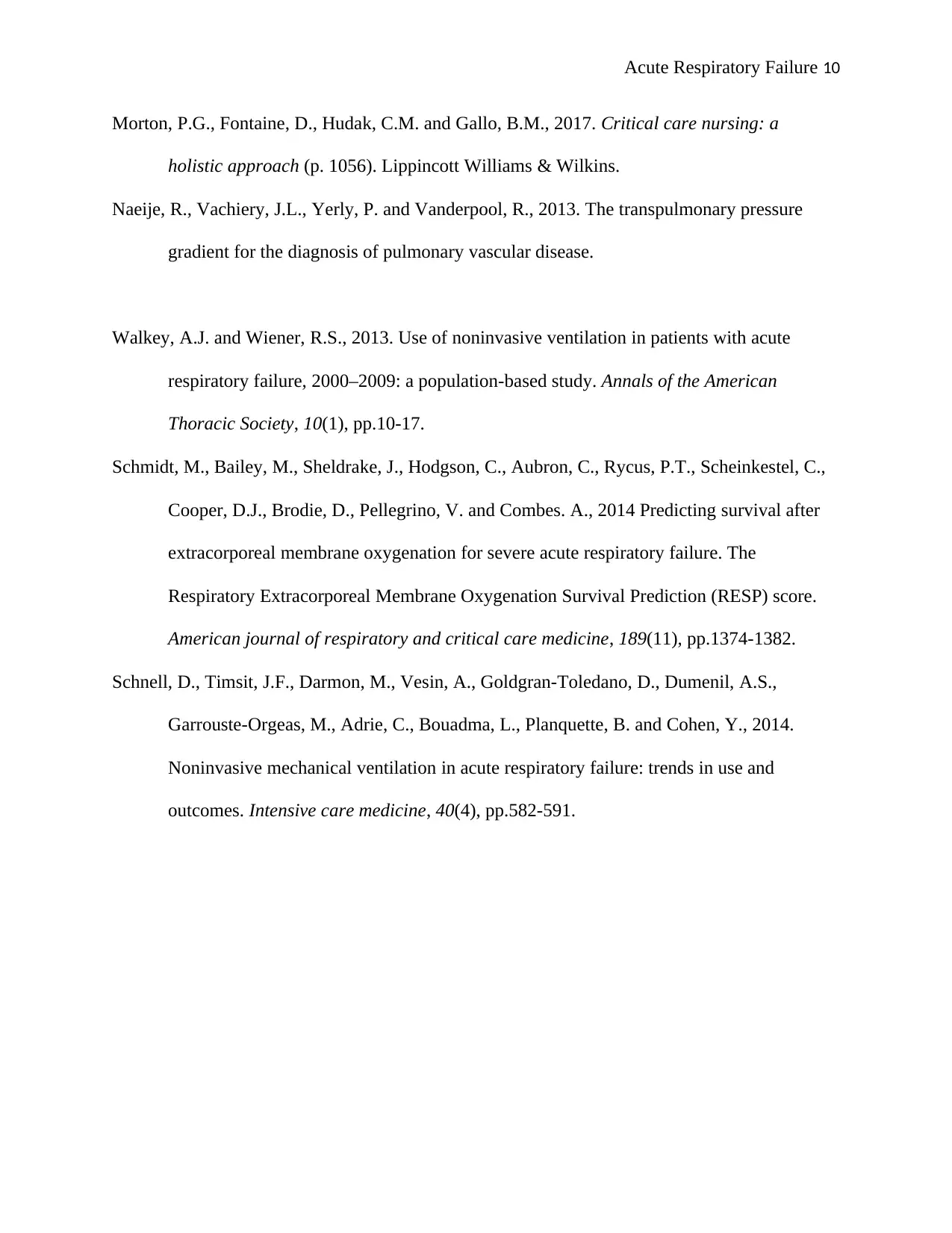
Acute Respiratory Failure 10
Morton, P.G., Fontaine, D., Hudak, C.M. and Gallo, B.M., 2017. Critical care nursing: a
holistic approach (p. 1056). Lippincott Williams & Wilkins.
Naeije, R., Vachiery, J.L., Yerly, P. and Vanderpool, R., 2013. The transpulmonary pressure
gradient for the diagnosis of pulmonary vascular disease.
Walkey, A.J. and Wiener, R.S., 2013. Use of noninvasive ventilation in patients with acute
respiratory failure, 2000–2009: a population-based study. Annals of the American
Thoracic Society, 10(1), pp.10-17.
Schmidt, M., Bailey, M., Sheldrake, J., Hodgson, C., Aubron, C., Rycus, P.T., Scheinkestel, C.,
Cooper, D.J., Brodie, D., Pellegrino, V. and Combes. A., 2014 Predicting survival after
extracorporeal membrane oxygenation for severe acute respiratory failure. The
Respiratory Extracorporeal Membrane Oxygenation Survival Prediction (RESP) score.
American journal of respiratory and critical care medicine, 189(11), pp.1374-1382.
Schnell, D., Timsit, J.F., Darmon, M., Vesin, A., Goldgran-Toledano, D., Dumenil, A.S.,
Garrouste-Orgeas, M., Adrie, C., Bouadma, L., Planquette, B. and Cohen, Y., 2014.
Noninvasive mechanical ventilation in acute respiratory failure: trends in use and
outcomes. Intensive care medicine, 40(4), pp.582-591.
Morton, P.G., Fontaine, D., Hudak, C.M. and Gallo, B.M., 2017. Critical care nursing: a
holistic approach (p. 1056). Lippincott Williams & Wilkins.
Naeije, R., Vachiery, J.L., Yerly, P. and Vanderpool, R., 2013. The transpulmonary pressure
gradient for the diagnosis of pulmonary vascular disease.
Walkey, A.J. and Wiener, R.S., 2013. Use of noninvasive ventilation in patients with acute
respiratory failure, 2000–2009: a population-based study. Annals of the American
Thoracic Society, 10(1), pp.10-17.
Schmidt, M., Bailey, M., Sheldrake, J., Hodgson, C., Aubron, C., Rycus, P.T., Scheinkestel, C.,
Cooper, D.J., Brodie, D., Pellegrino, V. and Combes. A., 2014 Predicting survival after
extracorporeal membrane oxygenation for severe acute respiratory failure. The
Respiratory Extracorporeal Membrane Oxygenation Survival Prediction (RESP) score.
American journal of respiratory and critical care medicine, 189(11), pp.1374-1382.
Schnell, D., Timsit, J.F., Darmon, M., Vesin, A., Goldgran-Toledano, D., Dumenil, A.S.,
Garrouste-Orgeas, M., Adrie, C., Bouadma, L., Planquette, B. and Cohen, Y., 2014.
Noninvasive mechanical ventilation in acute respiratory failure: trends in use and
outcomes. Intensive care medicine, 40(4), pp.582-591.
Paraphrase This Document
Need a fresh take? Get an instant paraphrase of this document with our AI Paraphraser

Acute Respiratory Failure 11
1 out of 11
Related Documents
Your All-in-One AI-Powered Toolkit for Academic Success.
+13062052269
info@desklib.com
Available 24*7 on WhatsApp / Email
![[object Object]](/_next/static/media/star-bottom.7253800d.svg)
Unlock your academic potential
Copyright © 2020–2025 A2Z Services. All Rights Reserved. Developed and managed by ZUCOL.





